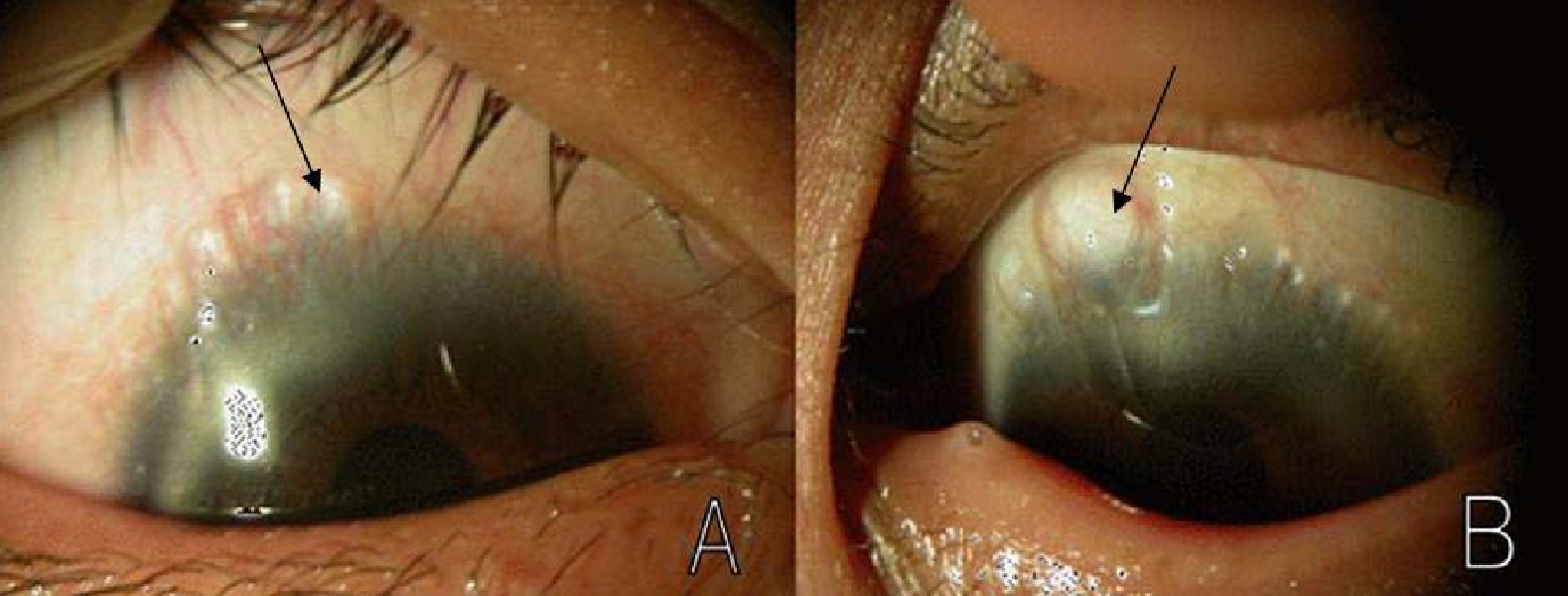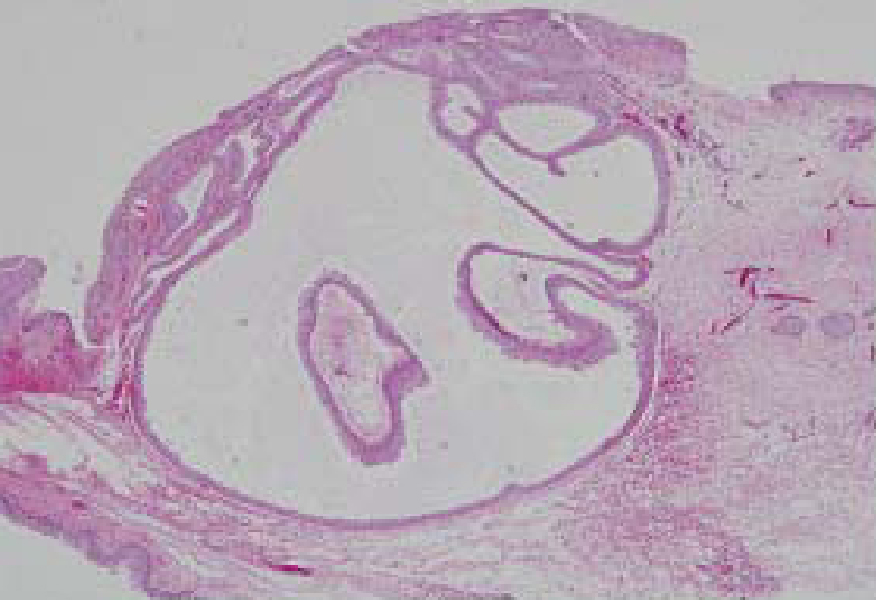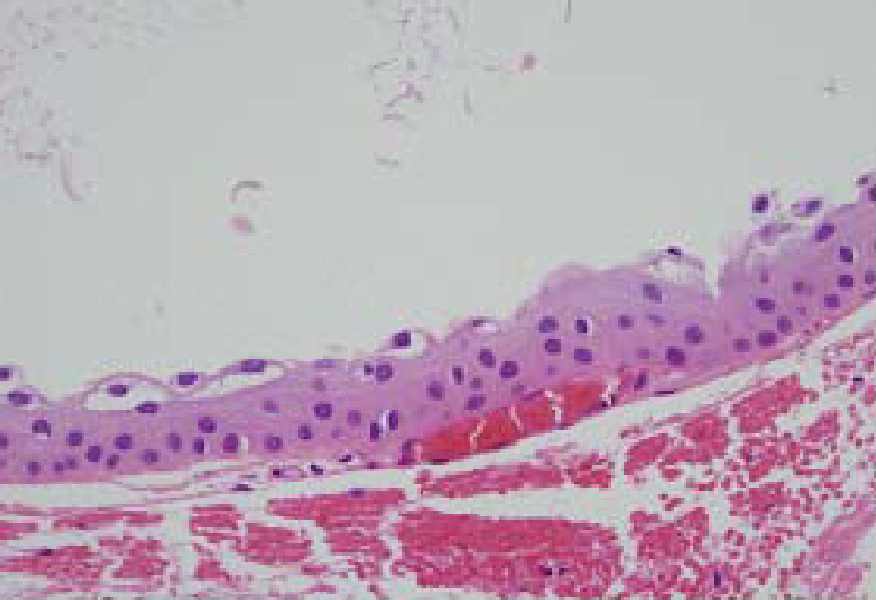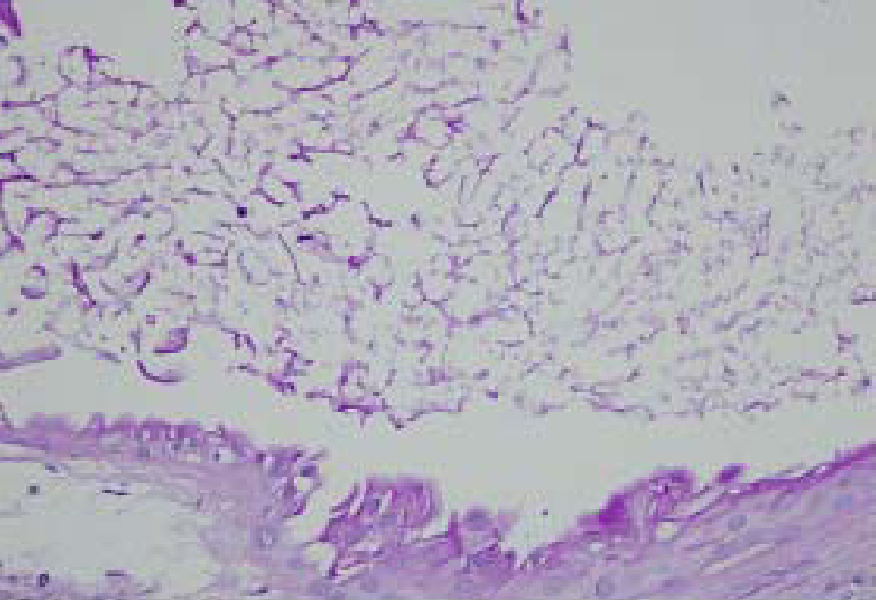Korean J Ophthalmol.
2007 Dec;21(4):251-254. 10.3341/kjo.2007.21.4.251.
Conjunctival Inclusion Cysts in Long-standing Chronic Vernal Keratoconjunctivitis
- Affiliations
-
- 1Department of Ophthalmology, Kyung Hee University College of Medicine, Seoul, Korea. khjinmd@khmc.or.kr
- 2Department of Ophthalmology, Kang Won University College of Medicine, Kangwon, Korea.
- KMID: 754645
- DOI: http://doi.org/10.3341/kjo.2007.21.4.251
Abstract
- PURPOSE: To report a case of conjunctival inclusion cysts on the corneal limbus of a patient with chronic vernal keratoconjunctivitis during 16 months' follow up. METHODS: The patient was a 26 year old male without any specific history of surgery or trauma. Giant papillae, shield ulcers, and Horner-Trantas dots were detected. During the 16 month follow-up, Sodium cromoglycate eye drops and Prednisolone acetate 1% eye drops were given 3 times a day. During this period, conjunctival cysts were detected on the corneal limbus in both eyes. In spite of improvement of the corneal and conjunctival conditions, the conjunctival cysts did not seem to show any specific changes. For relief of foreign body sensation, excision of the conjunctival cysts and giant papillae of the left eye and histopathologic examination of the specimen was performed. RESULTS: On histopathological examination, the conjunctival cysts consisted of nonkeratinizing stratified epithelial cells filled with PAS-positive mucous substance. Inflammatory cells were not found in the vicinity. CONCLUSIONS: Conjunctival inclusion cysts can be seen as an atypical finding of long-standing vernal keratoconjunctivitis. Mechanical friction between the giant papillae and conjunctiva may be a factor in inducing the formation of the conjunctival cysts.
Keyword
MeSH Terms
Figure
Reference
-
1. Trocme SD, Sra KK. Spectrum of ocular allergy. Curr Opin Allergy Clin Immunol. 2002. 2:423–427.2. BenEzra D, Pe'er J, Brodsky M, Cohen E. Cyclosporin eyedrops for the treatment of severe vernal keratoconjunctivitis. Am J Ophthalmol. 1986. 101:278–282.3. Grossniklaus HE, Green WR, Luckenbach M, Chan CC. Conjunctival lesions in adults. A clinical and histopathologic review. Cornea. 1987. 6:78–116.4. Jakobiec FA, Bonanno PA, Sigelman J. Conjunctival adnexal cysts and dermoids. Arch Ophthalmol. 1978. 96:1404–1409.5. Ho VT, Rao VM, Flanders AE. Postsurgical conjunctival epithelial cysts. AJNR Am J Neuroradiol. 1994. 15:1181–1183.6. Bourcier T, Monin C, Baudrimont M, et al. Conjunctival inclusion cyst following pars plana vitrectomy. Arch Ophthalmol. 2003. 121:1067.7. Finqer PT, McCormick SA, Lombardo J, et al. Epithelial inclusion cyst of the iris. Arch Ophthalmol. 1995. 113:777–780.8. Srinivasan BD, Jakobiec FA, Iwamoto T, Devoe AG. Epibulbar mucogenic subconjunctival cysts. Arch Ophthalmol. 1978. 96:857–859.9. Kiratli H, Bilgic S, Gokoz O, Sokmensuer C. Conjunctival epithelial inclusion cyst arising from a pterygium. Br J Ophthalmol. 1996. 80:769–770.10. Suzuki K, Okisaka S, Nakagami T. The contribution of inflammatory cell infiltration to conjunctival inclusion cyst formation. Nippon Ganka Gakkai Zasshi. 2000. 104:170–173.11. Jones BR. Trachoma and allied infections. Trans Ophthalmol Soc U K. 1961. 81:2115–2128.12. Kim YH, Oh SY, Ha JK, Shin MC. Amniotic membrene transplantation in the management of shield ulcers of vernal keratoconjunctivitis. J Korean Ophthalmol Soc. 2004. 45:315–318.13. Udell IJ, Gleich GJ, Allansmith MR, et al. Eosinophil granule major basic protein and Charcot-Leyden crystal protein in human tears. Am J Ophthalmol. 1981. 92:824–828.14. Trocme SD, Kephart GM, Bourne WM, et al. Eosinophil granule major basic protein deposition in corneal ulcers associated with vernal keratoconjunctivitis. Am J Ophthalmol. 1993. 115:640–643.15. Johnson DW, Bartley GB, Garrity JA, Robertson DM. Massive epithelium lined inclusion cysts after scleral buckling. Am J Ophthalmol. 1992. 113:439–442.16. Soong HK, Okayawa RT, Iliff NT. Corneal astigmatism from conjunctival cyst. Am J Ophthalmol. 1982. 93:118–119.17. de Bustros S, Michels RG. Treatment of acquired epithelial inclusion cyst of the conjunctiva using the YAG laser. Am J Ophthalmol. 1984. 98:807–808.
- Full Text Links
- Actions
-
Cited
- CITED
-
- Close
- Share
- Similar articles
-
- Therapeutic Effect of Cyclosporine A Eyedrops in Vernal Keratoconjunctivitis
- Co-cultivation of Adenovirus with Cultivated Conjunctival Epithelial Cell: Morphological Changes in Infected Cell
- A Case of Intractable Vernal Keratoconjunctivitis Treated by Papillectomy and Amniotic Membrane Transplantation
- Amniotic Membrane Transplantation in the Management of Shield Ulcers of Vernal Keratoconjunctivitis
- Self-inflicted Chronic Bacterial Keratoconjunctivitis Using Self Semen






